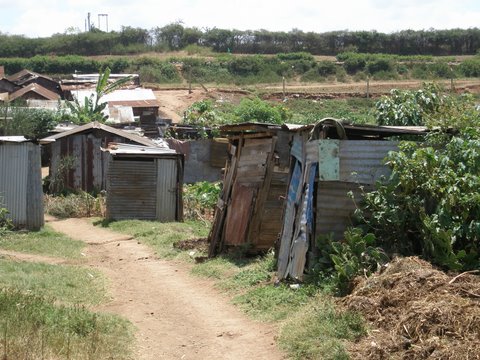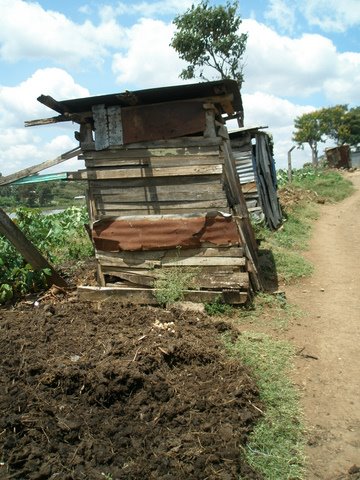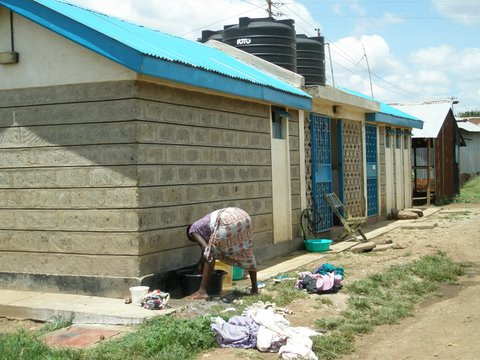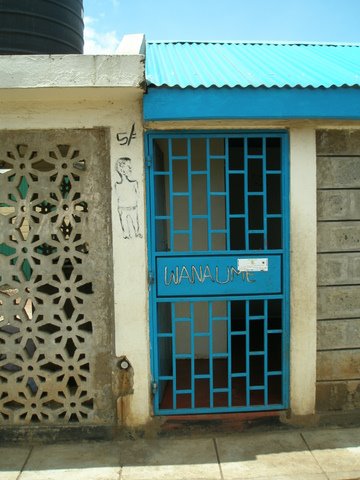Nairobi There are hardly better days that I have had as an organizer than the ones I have spent looking at the “turf” in a new city to decide, as best one can with four decades of experience, where we should start organizing new chapters. In the past I had fallen in love with the potential of the vast Kibera slum, and can hardly wait until the time is right for us there, but hard experience says that it is best to start and develop the experience and the model in an area where one can watch the variables more closely, nurture the success on a more secure “testing” ground, and then expand once the skill level and organizational capacity has increased. Preferably in this town I have called, NGO-bi, where donor dollars are one of the major sources of GNP, we would find a slum which is less chewed up than others….even though that might be mission impossible.
Anyway with the help of Lawrence Apiyo of COPA-K, we embarked on such a search through some of the slums while the air was still clear and crisp in the morning. We were looking as much at what had been done and what could be done, so it was an education as much as anything else. Lawrence was a good guide, since over the last 16 years; he has worked in most of these areas a time or two, so knew the stories and some of the people as we walked the dirt alleys in one settlement after another.
We started in Haruma, a relatively smallish slum with 4 distinct districts on the eastern side of the city. Pamoja Trust, where he had once worked and I had previously visited, had been involved heavily in this area in a slum “upgrading” project in one district where they had utilized the Slum Dwellers International (SDI) model for housing finance and construction, so this was fascinating as a project, though at 6000 families, not the area where we would begin our work. The SDI model is based on a combination of rigorous daily savings which is documented extensively and puts a family in line for a housing loan at various levels of savings and participation to then access a small loan for materials where they begin largely sweat equity, self-construction. After 5 years they had completed 86 or so houses for families of the 270 that they hoped to see finished in time of the 516 potential dwelling units in this section of Haruma. This was staged development requiring savings of 18000 Kenya shillings for the first level (about $265 USD), 12000 Ksh for the 2nd level ($170 USD), and 7500 Ksh for the 3rd level (about $100 USD). You can judge the improvements by the pictures. The land was provided free by the City Council of Nairobi. The land and housing is held in trust, meaning that if the resident moves or dies, the property goes back to the trust. There turn out to be a lot of issues between the various NGOs and the community about repayment rates, interest rates, and this that and the other, but it was undeniable in visiting with people in Haruma that they were pleased with their houses and committed to the project.
We drove by Matari, where the violence had been the most intense, and killings most widespread. Not high on my list, so we kept on going.
We spent a lot of time in Korogocho, perhaps the oldest slum in Nairobi dating back more than 40 years and next to Kibera, the second largest with more than 300,000 residents in 60,000 dwelling units. This actually might be where we start, if we can do some more looking. Seems to have been largely deserted by most of the big NGO’s and development agencies, and just stagnating, so it could be a place where we could try our unique brand of work and might get traction. Worth more discussion and looking, but I liked the size and feel of the area.
Lastly we looked at an area called Soweto that was a long way out. The part of Soweto we toured had seen some development started by the Pamoja Trust on six, houses about 3 levels high which towered over the wooden lean-to housing around them. The Trust had not been able to finish the houses though for some reason, I couldn’t quite fathom. The UN-Habitat had come in though and presented a comprehensive plan which I could see easily from the maps posted on the walls of the local “resource center” (community center?), but that was the only place where any of us could see the houses. The UN-Habitat developmental model is now to start first with sanitation, rather than housing, which has some appeal, since it does deliver something to the whole community. We saw one bath and restroom area that was finished with working water and 5 Ksh showers. The other was still working out drainage problems near the culvert and couldn’t be finished too soon from the looks of the outhouses teetering along the ridge at the bottom of the Soweto slope. There were also two garbage/recycling areas, which were harder to figure in talking to the residents, but I hope it has to do with recycling.
The other problem with the UN-Habitat effort centers on the profound distrust of the community from the members who talked frankly to us. They had not been able to settle with confidence on the eventual issue of title being held by the families to the houses. Part of the concern lay in a less than transparent role being played by the Catholic Church in the project. Seems some 25 years ago there had been a development where the Church had been a primary driver and as the houses were finished, residents were surprised to find that they were paying rents to the Church, rents some complained they could not afford, on a rent-to-purchase scheme to pay back the money used to build the structure. There were police evictions, teardowns, and all manner of mayhem based on what were probably miscommunications on the front end of the development. Nonetheless all of this later, residents still remembering what they had heard from that struggle were refusing to sign-off on anything finally with UN-Habitat until they knew exactly what the role of the Church would be and whether or not they would have title. I learned a world about Nairobi walking and listening on the dirt streets of Soweto.
The other fascinating thing I learned going from settlement to settlement reminded me of the old “community leader” problem 40 years ago in the US “war” on poverty — seems that some felt the UN-Habitat “muscled in” to the affection of leaders in Soweto because they pay more per day to the leaders in what is sometimes euphemistically called “lunch money,” which many NGOs are forced to pay. Some like the UN-Habitat pay up to 1000 Ksh per day. More normal seems to be about 300 Ksh/day (about $4 USD). Either of which beats the daily wage for many Kenyans.
ACORN International has a lot to teach as we build the organizing committees and introduce the radical concept of membership and self-support for organizations, but we also have a huge amount to learn as well, it seems.

the UN-Habitat in the Soweto slum of Nairobi



